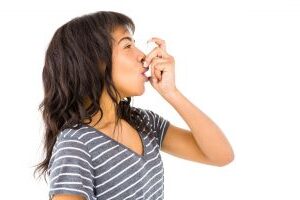
25 May COVID-19 and lung disease
The coronavirus, which is currently spreading throughout the world, is a source of uncertainty for many. It has not been adequately researched and there is currently no vaccine or medication proven to help against the virus. So the question is what patients with lung disease need to watch out for during this particular time. The presence of an underlying disease can potentially result in a much more severe course in the event of infection than in people without a pre-existing condition.
Thus, the proposed guidelines that the public should follow are of particular importance for patients with lung disease. They ensure that the risk of infection is kept as low as possible. The primary goal is to reduce the risk of infection. This can be achieved, among other things, by observing general rules of conduct1 , such as avoiding touching the mouth, nose or eyes2 , especially with unwashed hands, or contact with people who have the disease. In general, it is advisable to avoid contacts outside the own household as far as possible. In addition, thorough and regular hand washing2 after touching potentially contaminated surfaces is recommended.
Detailed information on how to deal with the current virus situation can be found everywhere on the Internet. However, it is extremely important to stick to reputable sources. We have listed some of them for you at the end of this article. You can find all of the federal government’s measures here:
https://www.bundesregierung.de/breg-de/themen/coronavirus/corona-massnahmen-1734724

It is also now easy to find instructions on how to wash your hands correctly. Our tip: WHO recommends singing the song “Happy Birthday” twice to ensure sufficient duration during each washing session. Here also a video of the University of Vienna, which explains correct hand washing easily:
In addition to droplet infection, aerosols are always emerging as the primary route of transmission. These are droplet nuclei that have a diameter smaller than 5 micrometers. To reduce this risk, closed rooms should always be ventilated as frequently and well as possible. Although a conclusive assessment is difficult at this time, overall, studies to date indicate that SARS-CoV-2 viruses can also be transmitted via aerosols in social settings.15
The clinical picture of COVID-19 should be known to individuals who belong to the at-risk group so that early self-recognition of symptoms is possible. In the event of contracting the viral infection, rapid contact3 to the family doctor’s office or by telephone to other advisory services is essential.
In this case, dial 116 or 117.4
If cases of COVID-19 are or become known in the immediate environment, this should also not be concealed under any circumstances.
Asthma and COVID-19
There are differences in the risk of infection depending on the severity of asthma. Asthmatics are normally no more at risk from coronavirus5 than healthy people if their asthma is well controlled. Well-adjusted means having no symptoms due to the asthma. This means, then, that only those patients who are also symptom-free are not at increased risk of infection.
However, if they have severe asthma and/or need to take cortisone tablets to control their symptoms, they may be at particular risk. For example, in such patients who have had asthma for a long time, pathological changes may have occurred in the lungs.6 In this case, the elasticity of the lung tissue decreases, which can lead to difficult breathing. In this case, the affected person is at greater risk of developing a more severe course of the viral infection.
This also applies to uncontrolled asthma. This may be the case, for example, if patients require the bronchodilator drug salbutamol more than twice a week or if the asthma has manifested itself due to a cold. If appropriate training is available, independent initiation of an increase in continuous therapy is possible.7
In patients with mild or episodic asthma, the risk of developing a severe expression of coronavirus is low6. However, in this case the regular intake of prescribed medication should not be neglected. Because well controlled asthmatics are in principle not more endangered by the coronavirus8 than healthy people.
In another hypothesis, asthmatics are even reported to be at lower risk due to reduced expression in the airways of the ACE-2 receptor responsible for SARS-CoV-2 uptake. This mainly affects patients with allergies and/or type 2 inflammation.9 If you are interested in detailed information about this risk assessment in patients with chronic respiratory and pulmonary diseases in the context of the SARS-CoV-2 pandemic, we recommend reading the following statement:
COPD and COVID-19
Unlike asthmatics, the lungs of COPD patients are already chronically altered by many years of smoking, for example. It may be stiffer and obstructively altered. Patients who suffer from more severe COPD and also require oxygen should stay indoors as much as possible and avoid crowds, according to recommendations. This patient group has a higher risk of developing a more severe course of coronavirus.10 For example, to minimize out-of-home contact, errands such as shopping could be done by friends or acquaintances.
If you are interested in a detailed risk assessment of patients with chronic respiratory and pulmonary disease in the context of the SARS-CoV-2 pandemic, we encourage you to read the following statement:

Taking the medications
Some medications have an immune-suppressive effect because the body’s defenses are dampened in the process. Especially in asthma treatment, they can have a central role and also have an anti-inflammatory effect.
Despite the immunosuppressive effect, it is strongly recommended to continue the adequate and individually adjusted antiasthmatic inhalation therapy9 and under no circumstances to discontinue the prescribed medication without consulting one’s own physician.
Discontinuing the medication could worsen the disease, resulting in a visit to the doctor or even hospitalization.10 There, in turn, the likelihood of encountering a COVID-19 sufferer and becoming infected is significantly increased. Because of this, it is essential at this time to continue successful inhaled therapy in asthmatics.
For asthma patients who take a break from therapy due to mild symptoms in the summer, it is recommended to discuss an extension of the therapy with the doctor. Under continuous therapy, the viral infection may be less severe.11
If you have been taking your basic therapy medications irregularly, you should change this right now. It’s the perfect time to start inhaling regularly again.
Our health application Kata® helps you to inhale correctly. It shows you how to inhale correctly in a simple and easy-to-understand way. In addition, the app reminds you to inhale and assesses whether you have completed the individual steps of your inhalation process so that the active ingredient has been delivered to the lungs in the best possible way. Kata® reports in text and image how successful your inhalation application was and documents your inhalation therapy. This can significantly improve treatment and therapy success. Don’t underestimate: correct inhalation is so important right now.


Trustworthy sources
It is enormously important to get your information from the right sources. Especially with such a sensitive topic as COVID-19, the risk regarding misinformation is increased. Also, the state of the art in science is always changing and even serious scientists admit that there cannot be a certain answer to all questions at the moment.
The following list contains sources that we consider trustworthy:
- ELF (European Lung Foundation) information: Answers from a Lung Specialist to Frequently Asked Questions about COVID-19 https://www.europeanlung.org/de/qa-covid-19
- Information from the German Federal Ministry of Health: https://www.bundesgesundheitsministerium.de/coronavirus.html
- Information from the Robert Koch Institute (RKI) Risk assessment on COVID 19: https://www.rki.de/DE/Content/InfAZ/N/Neuartiges_Coronavirus/nCoV.html
- Recommendations for intensive medical therapy of patients with COVID-19: https://link.springer.com/article/10.1007/s00063-020-00674-3
- Federal Center for Health Education: https://www.bzga.de/
- Infection Control: https://www.infektionsschutz.de/coronavirus.html
- World Health Organization: https://www.who.int/emergencies/diseases/novel-coronavirus-2019
- Information on symptoms and how to differentiate from influenza: https://www.116117.de/de/coronavirus.php
- Regulations & Restrictions – Federal Government: https://www.bundesregierung.de/breg-de/themen/coronavirus/corona-massnahmen-1734724
- Important questions and answers about coronavirus – Federal Government: https://www.bundesregierung.de/breg-de/themen/coronavirus/ausbreitung-coronavirus-1716188
But what should I look for to distinguish reputable sources from unserious sources?
Always keep in mind who is behind the information and what interests they may have. Be especially cautious when a cure or treatment to prevent the virus is touted.13 News stories that severely downplay the spread or dangerousness of coronavirus are also often alarming. If recommendations are made that contradict the information provided by public health authorities, you should first check this out very carefully. A healthy skepticism towards the information overflow is therefore highly recommended.
Further information on how to distinguish trustworthy from untrustworthy sources can be found in the following link (https://www.infektionsschutz.de/coronavirus/verlaessliche-informationen-erkennen.html#c12327).
SOURCES
1 https://www.rki.de/DE/Content/InfAZ/N/Neuartiges_Coronavirus/Risikogruppen.html
2 https://www.lungeninformationsdienst.de/themenmenue/news/alle-news-im-ueberblick/aktuelles/article/coronavirus-infos-fuer-menschen-mit-lungenkrankheiten/index.html
3 https://www.rki.de/DE/Content/InfAZ/N/Neuartiges_Coronavirus/Risikogruppen.html
4 https://www.116117.de/de/coronavirus.php
5 https://www.mein-allergie-portal.com/pollenallergie-heuschnupfen/2610-die-birke-blueht-covid-19-allergien-und-asthma.html
6 https://www.mein-allergie-portal.com/asthma/2585-coronavirus-asthma-bei-erwachsenen-wer-ist-risikopatient.html
7 https://www.mein-allergie-portal.com/allergie-und-unvertraeglichkeit-beim-kind/2578-coronavirus-und-asthma-beim-kind-was-wenn-es-unkontrolliert-ist.html
8 https://www.mein-allergie-portal.com/asthma/2566-coronavirus-und-asthma-hoeheres-risiko-fuer-asthmatiker.html
9 https://pneumologie.de/fileadmin/user_upload/COVID-19/20200527_DGP_BdP_Risikoabschaetzung_chron._LK_SARS-CoV-2_update.pdf
10 https://www.mein-allergie-portal.com/copd/2614-coronavirus-und-copd-welche-risiken-gibt-es.html
11 https://pneumologie.de/fileadmin/user_upload/Aktuelles/2020-03-16_Statement_Asthma_und_COVID-19_F.pdf
12 https://www.lungeninformationsdienst.de/aktuelles/news/alle-news-im-ueberblick/aktuelles/article/coronavirus-asthma-medikamente-wie-gewohnt-einnehmen/index.html
13 https://www.mein-allergie-portal.com/asthma/2612-corona-asthma-wie-umgehen-mit-der-sommerlichen-therapiepause.html
14 https://www.infektionsschutz.de/coronavirus/verlaessliche-informationen-erkennen.html#c12327
15 https://www.rki.de/DE/Content/InfAZ/N/Neuartiges_Coronavirus/Steckbrief.html
